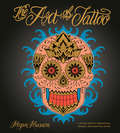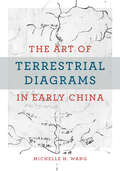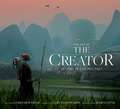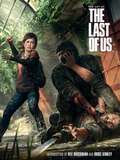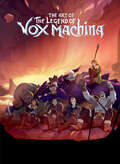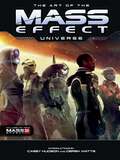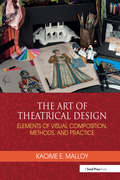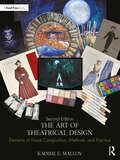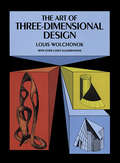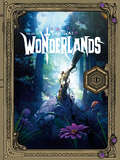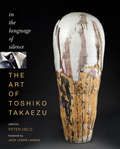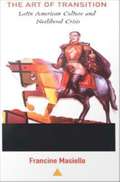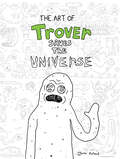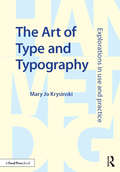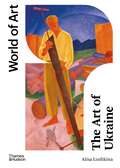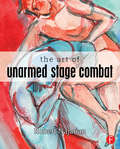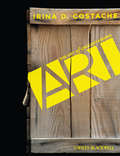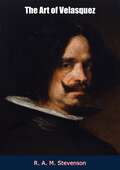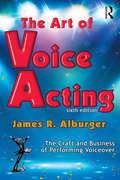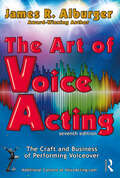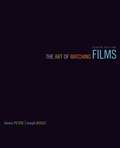- Table View
- List View
The Art of Tattoo: A Tattoo Artist's Inspirations, Designs, and Hard-Won Advice
by Megan MassacreTattoo artist Megan Massacre presents a beautiful collection of her best work, with instructive how-to and inspiration for both professional tattoo artists as well as tattoo aficionados. With a personal behind-the-scenes peek into the making of a tattoo, from concept to execution, plus fan favorite tattoos and tattoo cover-ups, this approachable, full-color paperback will feature everything Massacre has learned over the years. Part idea sourcebook, part tattoo opus, this is an art book that tattoo fans will be eager to read and display.
The Art of Teaching Secondary English: Innovative and Creative Approaches
by David Stevens Nicholas McGuinnAt a time when school-based English is in danger of becoming reductive and mechanistic, the authors of this book reconsider the fundamental philosophy of English teaching, evaluate current practice and offer a practical framework for new approaches to teaching this important subject. The authors draw on recent initiatives in the area, including the National Literacy Strategy, but also offer wider perspectives on the formation and development of both English and English teaching in a modern society. This will help teachers develop both a personal philosophy and a critical perspective on the various traditions of English teaching as well as on current initiatives and reforms. The book includes: provocative quotations from writers, artists and thinkers responses to key figures in modern educational thought exploration and development of the principle areas, illuminating key issues, tensions and opportunities practical possibilities for classroom practice. The Art of Teaching Secondary English is a practical and accessible resource for everyone involved in English teaching.
The Art of Terrestrial Diagrams in Early China
by Michelle H. WangA study of early Chinese maps using interdisciplinary methods. This is the first English-language monograph on the early history of maps in China, centering on those found in three tombs that date from the fourth to the second century BCE and constitute the entire known corpus of early Chinese maps (ditu). More than a millennium separates them from the next available map in the early twelfth century CE. Unlike extant studies that draw heavily from the history of cartography, this book offers an alternative perspective by mobilizing methods from art history, archaeology, material culture, religion, and philosophy. It examines the diversity of forms and functions in early Chinese ditu to argue that these pictures did not simply represent natural topography and built environments, but rather made and remade worlds for the living and the dead. Wang explores the multifaceted and multifunctional diagrammatic tradition of rendering space in early China.
The Art of The Boxtrolls
by Travis Knight Philip Brotherton Anthony StacchiLAIKA, the studio behind the hit films Coraline and ParaNorman, introduces audiences to a new breed of family: the Boxtrolls, a community of quirky, mischievous creatures who have lovingly raised an orphaned human boy named Eggs in the amazing cavernous home they've built beneath the streets of Cheesebridge. When the town's villain, Archibald Snatcher, comes up with a plot to get rid of the Boxtrolls, Eggs decides to venture above ground where he meets and teams up with fabulously feisty Winnie to devise a daring plan to save Eggs' family. The Art of The Boxtrolls features the amazingly detailed artwork that went into this film's creation, including character sketches, puppets, textiles, set dressing, and 3-D printed facial models, alongside the story of the film's development.
The Art of The Creator: Designs of Futures Past
by James MottramDiscover the secrets behind the creation of director Gareth Edwards&’s remarkable science-fiction adventure, The Creator.Dive into the making of The Creator, an original science fiction adventure from director Gareth Edwards (Rogue One: A Star Wars Story, Godzilla), with this deluxe behind-the-scenes book. Amid a war between humankind and rampant artificial intelligence in the not-too-distant future, Joshua (John David Washington) is recruited to hunt down and kill the Creator, the elusive architect of the advanced AI. In his efforts to defeat the AI, Joshua discovers that the world-ending weapon he&’s been instructed to destroy is an AI in the form of a young child. Featuring commentary from Gareth Edwards and his crew, including production designer James Clyne, plus the extraordinary cast including John David Washington, Gemma Chan, Allison Janney, and Ken Watanabe, this exclusive volume tells the full story of the film&’s creation. Illustrated with stunning visuals from the production of the movie, including remarkable concept art that charts the film&’s evolution, this book is the ultimate companion to one of the most original and innovative films of 2023. NEVER-BEFORE-SEEN IMAGERY: Go behind the scenes of The Creator with candid photos from the shoot and exclusive production art. INTERVIEWS WITH CREATORS AND CAST: Dive into the creation of the film through exclusive interviews with director Gareth Edwards, his crew, and the film&’s cast. EXPERIENCE THE CREATIVE JOURNEY: Follow The Creator through its entire creative process, from script to screen, told from the point of view of the film&’s director, his crew and the producers at New Regency.
The Art of The Last of Us (The Last of Us)
by VariousNaughty Dog Studios and Dark Horse proudly present the essential companion to The Last of Us, a richly detailed and compelling game set in a postpandemic world where humans have become an endangered species. Featuring concept art, character designs, and astonishing settings and landscapes, The Art of The Last of Us provides a unique look at one of the gaming world's most eagerly anticipated titles. * A must-have companion to the game. * Incredible full-color artwork! * The latest project from Naughty Dog Studios. * The Last of Us swept the top Game Critics awards at 2012's E3 conference.
The Art of The Legend of Vox Machina
by Meredith KecskemetyThe adventure begins in the hit TV series The Legend of Vox Machina! Follow Vex&’halia, Vax&’lidan, Keyleth, Grog Strongjaw, Scanlan Shorthalt, Pike Trickfoot, and Percy de Rolo as they set off to save Exandria from dark forces.Experience Exandria again with character breakdowns, concept art, and a behind-the-scenes look into the creation of the show with Legend of Vox Machina writer Meredith Kecskemety, along with special commentary from the cast.
The Art of The Mass Effect Universe (Mass Effect)
by Casey HusdonThe Mass Effect trilogy is a groundbreaking epic that has immersed gamers in one of science fiction's richest universes. Now BioWare and Dark Horse are proud to invite fans deeper than ever into the Mass Effect saga with The Art of the Mass Effect Universe! Featuring concept art and commentary by BioWare on the games' characters, locations, vehicles, weapons, and more (including Mass Effect 3) The Art of the Mass Effect Universe is the most complete companion available to gaming's most compelling series!
The Art of Theatrical Design: Elements of Visual Composition, Methods, and Practice
by Kaoime MalloyThe Art of Theatrical Design: Elements of Visual Composition, Methods, and Practice addresses the core principles that develop the student designer into a true artist, providing a foundation that ensures success with each production design. This text concentrates on the skills necessary to create effective, evocative, and engaging theatrical designs that support the play contextually, thematically, and visually. It gives students the grounding in core design principles they need to approach design challenges and make design decisions in both assigned class projects and realized productions. This book features: In-depth discussions of design elements and principles for costume, set, lighting, sound, and projection designs Coverage of key concepts such as content, context, genre, style, play structure and format, and the demands and limitations of various theatrical spaces Essential principles, including collaboration, inspiration, conceptualization, script analysis, conducting effective research, building a visual library, developing an individual design process, and the role of the critique in collaboration Information on recent digital drawing tool technology, such as the Wacom® Inkling pen, Wacom® Intuos digitizing tablets and digital sketching, and rendering programs such as Autodesk® Sketchbook Pro and Adobe® Photoshop® Chapter exercises and key terms designed to provide an engaging experience with the material and to facilitate student understanding
The Art of Theatrical Design: Elements of Visual Composition, Methods, and Practice
by Kaoiṁe E. MalloyThe Art of Theatrical Design: Elements of Visual Composition, Methods, and Practice, Second Edition, contains an in-depth discussion of design elements and principles for costume, set, lighting, sound, projection, properties, and makeup designs. This textbook details the skills necessary to create effective, evocative, and engaging theatrical designs that support a play contextually, thematically, and visually. It covers key concepts such as content, context, genre, style, play structure, and format and the demands and limitations of various theatrical spaces. The book also discusses essential principles, including collaboration, inspiration, conceptualization, script analysis, conducting effective research, building a visual library, developing an individual design process, and the role of the critique in collaboration. This second edition includes A new chapter on properties management and design. A new chapter on makeup design. A new chapter on digital rendering, with evaluations of multiple programs, overviews of file types and uses, and basic tutorials in Adobe® Photoshop® and Procreate. An expanded and revised chapter on traditional rendering, with the inclusion of new media, including watercolor, gouache, and mixed media, and updated exercises and tutorials. Revised and expanded chapters on individual design areas, including additional practices for conceptualization and collaboration, with new exercises for skill development. Additional exercises in all elements and principles of design chapters for investigation of each design principle and skill development. Revised and updated content throughout the text, reflecting current pedagogy and practices. This book gives students in theatrical design, introduction to design, and stagecraft courses the grounding in core design principles they need to approach design challenges and make design decisions in both assigned class projects and realized productions. The Art of Theatrical Design provides access to additional online resources, including step-by-step video tutorials of the exercises featured in the book.
The Art of Three-Dimensional Design (Dover Art Instruction)
by Louis WolchonokProfusely illustrated guide shows how basic shapes and surfaces -- plane, prismatic, cylindric, conical, spherical, and more -- can be adapted and combined to create hundreds of new designs. Applications are endless. Also covers properties of various materials, tools, collaborating with other designers, more. Over 100 illustrations.
The Art of Tinkering: Meet 150+ Makers Working at the Intersection of Art, Science & Technology
by Exploratorium Karen Wilkinson Mike PetrichSome of the most creative artists from today&’s maker scene discuss their process, workspaces and more in this inspiring guide to tinkering. The Art of Tinkering is an unprecedented celebration of what it means to tinker: to take things apart, explore tools and materials, and build wondrous, wild art that&’s part science, part technology, and entirely creative. Join 150+ makers as they share the stories behind their beautiful and bold work—then do some tinkering yourself! This collection of exhibits, artwork, and projects explores a whole new way to learn, in which people expand their knowledge through making and doing, working with readily available materials, getting their hands dirty, collaborating with others, and problem-solving in the most fun sense of the word. Each artist featured in The Art of Tinkering shares their process and the backstory behind their work. Whether it&’s dicussing their favorite tools (who knew toenail clippers could be so handy?) or offering a glimpse of their workspaces (you&’d be amazed how many electronics tools you can pack into a pantry!), the stories, lessons, and tips in The Art of Tinkering offer a fascinating portrait of today&’s maker scene. Artists include: Scott Weaver, Arthur Ganson, Moxie, Tim Hunkin, AnnMarie Thomas, Ranjit Bhatnajar and Jie Qi.
The Art of Tiny Tina's Wonderlands
by Amy RatcliffeA fantastic, full-color, oversized hardcover that chronicles the making of Gearbox&’s genre-mashing looter shooter!Go beyond the Borderlands with The Art of Tiny Tina&’s Wonderlands! Embark on a chaotic adventure that reimagines a cast of unforgettable characters as players journey through the Wonderlands. Admire the details of Tiny Tina&’s tabletop world in this handsome hardcover filled with the unique concept art of the environments, creatures, weapons, and characters we all know and love from the minds behind the Borderlands franchise! Join in the fun and become the ultimate Fatemaker by exploring The Art of Tiny Tina&’s Wonderlands! If you don't get it, Tiny Tina is gonna start crying!
The Art of Toshiko Takaezu: In the Language of Silence
by Peter HeldTracing the artistic development of renowned potter Toshiko Takaezu, this masterful study celebrates and analyzes an artist who holds a significant place in the post-World War II craft movement in America. Born in Hawaii of Japanese descent in 1922, Takaezu has worked actively in clay, fiber, and bronze for over sixty years. Influenced by midcentury modernism, her work has transformed from functional vessels to abstract sculptural forms and installations. Over the years, she has continued to draw on a combination of Eastern and Western techniques and aesthetics, as well as her love of the natural world. In particular, Takaezu's vertical closed forms have become a symbol of her work, created through a combination of wheel-throwing and hand-building techniques that allowed her to grow her vessels vertically and eased the circular restrictions of the wheel. In addition to her art, Takaezu is renowned for her teaching, including twenty years at Princeton University. This beautifully illustrated book offers the first scholarly analysis of Takaezu's life work and includes essays by Paul Smith, director emeritus of the American Craft Museum, and Janet Koplos, former senior editor ofArt in America. Jack Lenor Larsen, a textile designer, author, collector, and advocate of traditional and contemporary craftsmanship, provides a foreword.
The Art of Transition: Latin American Culture and Neoliberal Crisis
by Francine MasielloThe Art of Transition addresses the problems defined by writers and artists during the postdictatorship years in Argentina and Chile, years in which both countries aggressively adopted neoliberal market-driven economies. Delving into the conflicting efforts of intellectuals to name and speak to what is real, Francine Masiello interprets the culture of this period as an art of transition, referring to both the political transition to democracy and the formal strategies of wrestling with this change that are found in the aesthetic realm. Masiello views representation as both a political and artistic device, concerned with the tensions between truth and lies, experience and language, and intellectuals and the marginal subjects they study and claim to defend. These often contentious negotiations, she argues, are most provocatively displayed through the spectacle of difference, which constantly crosses the literary stage, the market, and the North/South divide. While forcefully defending the ability of literature and art to advance ethical positions and to foster a critical view of neoliberalism, Masiello especially shows how issues of gender and sexuality function as integrating threads throughout this cultural project. Through discussions of visual art as well as literary work by prominent novelists and poets, Masiello sketches a broad landscape of vivid intellectual debate in the Southern Cone of Latin America. The Art of Transition will interest Latin Americanists,literary and political theorists, art critics and historians, and those involved with the study of postmodernism and globalization.
The Art of Trover Saves the Universe
by Squanch GamesAn oversized full-color art book showcasing the insane imagination of Rick and Morty co-creator Justin Roiland! Save the universe! Save your dogs! Take your chair to the streets and follow Trover throughout the cosmos as you battle your way through hordes of clones on your quest to stop Glorkon! This freaky and awesome hardcover art book is the perfect companion to Squanch Games's first full length game! Feast your eye holes on 192 pages of crazy concept art and intimate commentary! Dark Horse Books and Squanch Games invite you to embrace weirdness by picking up the greatest art book in the galaxy! Or don't. It's whatever. I'm not your dad.
The Art of Type and Typography: Explorations in Use and Practice
by Mary Jo KrysinskiThe Art of Type and Typography is an introduction to the art and rules of typography. Incorporating the industry standard—InDesign—for typesetting from the outset, this book serves as a guide for beginning students to learn to set type properly through tutorials, activities, and examples of student work. Encompassing the history of typography from ancient times to widespread modern use, The Art of Type and Typography provides context and fosters creativity while developing key concepts, including: The history of type; Terminology; Classification; Measurement; Spacing; Alignment; Legibility; Hierarchy; Layout and Grids; Page Elements; InDesign tools and style sheets. Writing clearly and to the point, Mary Jo Krysinski brings over 30 years of design experience to this essential guide. With a glossary, sample class activities, additional online resources and a beautiful clean design, this book is the perfect introduction for a beginning typography student, and a handy reference for those needing a refresher.
The Art of Ukraine (World of Art #0)
by Alisa LozhkinaAn in-depth overview of Ukrainian art from the dawn of modernism in the late nineteenth century to the start of the Russian invasion in winter 2022. This new volume in the World of Art series provides an overview of Ukrainian art, artists, and art movements from the dawn of modernism and the 1900s to the Soviet period, to post-Soviet times and the beginning of the Russian invasion in February 2022. Ukrainian art and artists are discussed within historical and political contexts as well as how they have contributed to, and interacted with, Ukrainian culture and identity. Filled with rich illustrations, each chapter explores a different art period or movement. We are at a historical moment where Ukraine and its cultural identity are in grave danger, and author Alisa Lozhkina offers a powerful opportunity to connect curious and empathetic readers with the Ukrainian art tradition.
The Art of Unarmed Stage Combat
by Robert NajarianThe Art of Unarmed Stage Combat is your guide to the principles and techniques of theatrical violence, combining detailed discussions of the mechanics of stage fighting with the nuances of acting decisions to make fighting styles reflect character and story. Expert Fight Director Robert Najarian offers never-before-published games and exercises that will allow you to develop the skills and concepts for performing violence for stage and screen. This title utilizes a unique system of training techniques that result in stage violence that is both physically engaging for you as a performer, while remaining viscerally engaging for the audience.
The Art of Uncharted 4: A Thief's End
by VariousJourney alongside Nathan Drake once again, as Naughty Dog and Dark Horse Books team up to bring you this comprehensive and breathtaking exploration into Uncharted 4: A Thief's End! Numerous never-before-seen designs and concept art accompanied by commentary from the developers give you behind-the-scenes access to the creation of this gaming masterwork. This beautiful oversized hardcover is a must-have for any fan of the Uncharted franchise and high quality video game art.The Art of Unchartend 4 will be released by Dark Horse simultaneoulsy with the new game, Uncharted 4.
The Art of Understanding Art
by Irina D. CostacheThe Art of Understanding Art reveals to students and other readers new and meaningful ways of developing personal ideas and opinions about art and how to express them with confidence. Offers an inquiry--unique among introductory art texts--into the learning process of understanding and appreciating art Examines the multiple issues and processes essential to making, analyzing and evaluating art Uses cross-cultural examples to help readers develop comprehensive, yet personal, ways of looking at and thinking about art Includes an annotated glossary of the 'Art World', institutions and individuals that play a role in defining art as well as diagrams, textboxes callouts and other visual elements to highlight information and enhance learning Richly illustrated with over 40 images Suggests innovative class assignments and projects useful for developing lesson plans, and offers an online companion site for additional illustrations and information
The Art of Velasquez
by R. A. M. StevensonAn excellent, detailed and illustrated biography of Diego Rodríguez de Silva y Velázquez, 1599-1660, whose artworks adorn the museums and palaces worldwide. “Diego Rodríguez de Silva y Velázquez, the most admired—perhaps the greatest—European painter who ever lived, possessed a miraculous gift for conveying a sense of truth. He gave the best of his talents to painting portraits, which capture the appearance of reality through the seemingly effortless handling of sensuous paint.Because most of Velázquez’s work was carried out for the king, it remained in palaces where few people saw it. Not until the upheavals caused by Napoleon’s Peninsular War (1808–14) was some of his work dispersed throughout Northern Europe. In the nineteenth-century, his paintings made an enormous impact upon artists, and to the present day Velázquez is remembered as the painter’s painter.”—Everett FahyRobert Alan Mowbray Stevenson (1847–1900) was a Scottish art critic, a cousin of the writer Robert Louis Stevenson and the brother of Katharine de Mattos.
The Art of Voice Acting: The Craft and Business of Performing for Voiceover
by James AlburgerThe Art of Voice Acting covers all aspects of the craft and business of performing voiceover. This sixth edition is reorganized and completely updated to include the latest information on how to get started in voiceover, performing techniques, setting up a personal recording space, voiceover demos, the basics of running a voiceover business, working with agents, unions, and much more. Dozens of URL’s are included with additional resources and several chapters include all new scripts written specifically for this edition. Two new chapters include contributions from some of the voiceover world’s top professionals. Additional content can be found on the Voice Acting Academy website at AOVA.VoiceActing.com. This is the perfect tool for aspiring voice performers, radio announcers, and stage and screen actors.
The Art of Voice Acting: The Craft and Business of Performing for Voiceover
by James R. AlburgerNow in its seventh edition, The Art of Voice Acting covers all aspects of the craft and business of performing voiceover. Starting with the basics of voice acting, every aspect of the craft and business of performing voiceover is explained in detail, including how to get started, performing techniques, setting up a personal recording space, voiceover demos, the basics of running a voiceover business, unions and much, much more. This edition is completely updated with all new scripts, discussions of the latest trends in voiceover and contributions from some of the voiceover industry’s top performers, casting directors and agents. The book provides a wealth of practical information that can be put to work immediately, as well as hundreds of references to websites and other useful resources. Anyone interested in acting, storytelling, any area of voiceover or simply improving verbal communication skills will benefit from this book. Although The Art of Voice Acting is a great learning tool for the beginner, it will also serve the experienced performer well as a reminder of performing and business tools that are essential in today’s world of acting and voiceover. Additional content, including scripts, audio files, and unpublished content can be found at www.AOVA.VoiceActing.com.
The Art of Watching Films (8th Edition)
by Dennis Petrie Joe BoggsWith an emphasis on the narrative film,The Art of Watching Films challenges students to take their film experience further by sharpening their powers of observation, developing the skills and habits of perceptive watching, and discovering complex aspects of film art that they might otherwise overlook. The Art of Watching Films introduces the formal elements and production process of films, and helps students analytically view and understand films within their historical, cultural and social contexts. The text presents an analytical framework that can be applied to all movies, as distinctly different as Avatar, The Girl with the Dragon Tattoo, Vertigo, Iron-Man, Man on Wire, and The Hurt Locker.
